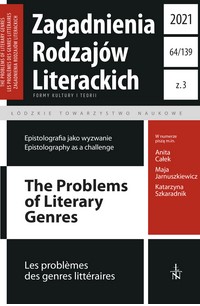Dialogowość listu w świetle koncepcji polifonicznego Ja
The Letter as a Dialogue in the Context of Dialogical Self Theory
Author(s): Anita CałekSubject(s): History of Psychology, Individual Psychology, Psychology of Self
Published by: Łódzkie Towarzystwo Naukowe
Keywords: epistolography; theory of the letter; Dialogical Self; Friedemann Schulz von Thun; Hubert J.M. Hermans; Stefania Skwarczyńska;
Summary/Abstract: The article is focused on the phenomenon of dialogicality in the letter, which is first discussed in the light of the existing theories (proposed by Stefania Skwarczyńska or Brigitte Diaz) and extended with new aspects of the definition of the letter, proposed in the New Theory of the Letter [Nowa teoria listu] by Anita Całek. In the next part, for the analysis of the dialogical nature of epistolography, a new research perspective is proposed: the dialogical self theory, whose creator and promoter is, above all, Hubert J.M. Hermans. The researcher, inspired by Mikhail Bakhtin’s concept on a polyphonic novel, pointed out how important the phenomenon of internal dialogues with oneself is for identity. The self can be perceived as a multivoiced structure of meanings: every voice is with a relatively autonomous I-position engaging in internal dialogues. This concept is combined and developed in Poland by Małgorzata Puchalska-Wasyl and Piotr K. Oleś, with the communicative approach of Friedemann Schulz von Thun, who proposed a model of the “internal team” containing internalized roles that an individual is able to assume by conducting internal dialogues. Both concepts are used for epistolographic analysis, seeing in the letter a medium of such dialogicality: the sender simultaneously plays his own role and creates in the imagination the figure of the recipient — which is actually the inner voice of his own self — a dialogue with her in the letter. This imaginary conversation is possible because the subject produces two dialogue voices, gives them autonomy, and for the needs of a specific correspondent, creates a epistolary character who represents him in this epistolary conversation. The indicated mechanism, which has its psychological justification in the theory of dialogic self and communicative psychology, allows to explain changes in the subject’s self-image in categories other than those used so far (such as self-presentation or self-creation).
Journal: Zagadnienia Rodzajów Literackich
- Issue Year: 64/2021
- Issue No: 3
- Page Range: 25-41
- Page Count: 17
- Language: Polish

